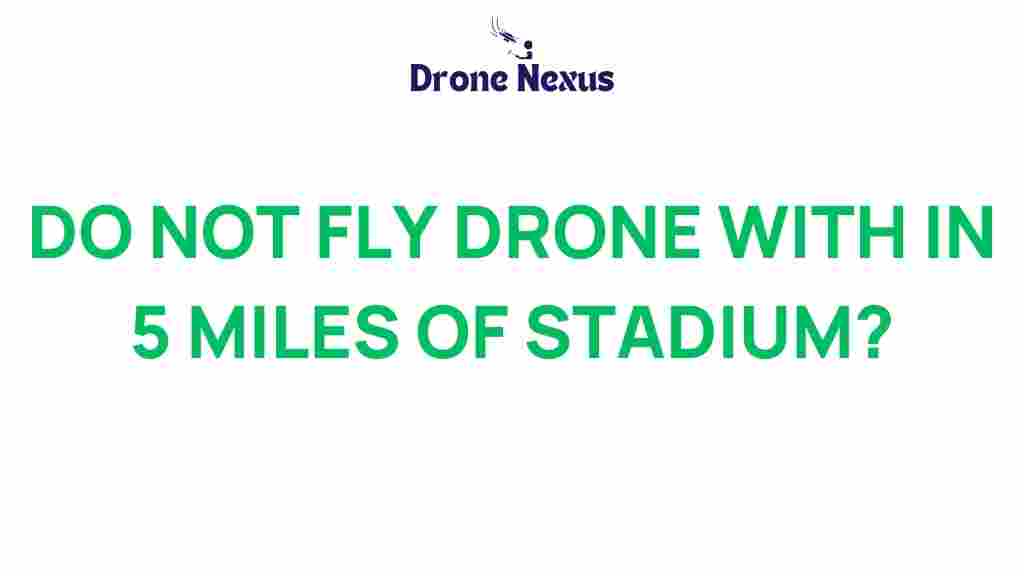Understanding Drone Regulations: Why You Should Never Fly a Drone Within 5 Miles of a Stadium
In the age of technology, drones have transformed from being mere gadgets to essential tools for photography, surveying, and even recreational use. However, with great power comes great responsibility. If you’re a drone enthusiast or operator, it’s crucial to understand the drone regulations that govern where you can and cannot fly. One of the most significant rules you must adhere to is avoiding flying within 5 miles of a stadium. In this article, we will explore the reasons behind this regulation, its implications, and provide guidance to ensure you stay compliant while enjoying your drone-flying experience.
The Importance of Drone Regulations
Drone regulations are designed to ensure the safety of both drone operators and the general public. These rules are put in place by aviation authorities like the Federal Aviation Administration (FAA) in the United States, which aims to prevent accidents and maintain order in the airspace. Ignoring these regulations can lead to severe consequences, including fines, loss of your drone, or even criminal charges.
Why You Should Avoid Flying Near Stadiums
Flying a drone near a stadium poses several risks, which is why drone regulations explicitly prohibit flying within 5 miles of such venues. Here are some key reasons:
- High Crowds: Stadiums are often filled with thousands of spectators, making them a high-risk area for drone flights. In the event of a drone malfunction or collision, the potential for injury is significantly increased.
- National Security: Major sporting events often attract the attention of national security agencies. Drones in these areas may raise alarms and provoke a security response.
- Privacy Concerns: Drones can invade the privacy of individuals attending events, leading to potential legal issues and public backlash.
- Interference with Emergency Services: In emergencies, first responders may need unimpeded access to the area. Drones can impede their operations and create dangerous situations.
Understanding the Regulations
To comply with the drone regulations surrounding stadiums, it’s vital to understand the specific rules set forth by the FAA and other regulatory bodies:
- 5-Mile No-Fly Zone: Drones cannot be flown within a 5-mile radius of stadiums while events are taking place. This rule is in effect for all major sporting events, including football, basketball, baseball, and concerts.
- Notification Requirements: If you plan to fly a drone near a stadium, it’s important to check for any notifications from the FAA or local authorities regarding special events that may impose additional restrictions.
- Temporary Flight Restrictions (TFR): The FAA may issue TFRs during significant events, which will outline specific no-fly zones and times. Always check for TFRs before flying.
Step-by-Step Process to Ensure Compliance
To ensure that you are adhering to drone regulations and avoiding any prohibited areas, follow these steps:
- Research: Before planning your drone flight, research the area and any upcoming events at local stadiums. Use resources like the FAA’s UAS Data Delivery System to check for TFRs.
- Check the 5-Mile Radius: Utilize online tools or apps designed to help drone operators check no-fly zones. Many apps provide real-time updates on airspace restrictions.
- Notify Authorities if Necessary: If you have a legitimate reason to fly near a stadium, contact local authorities for guidance or permission. This step is crucial for compliance.
- Maintain Visual Line of Sight: Always keep your drone within your visual line of sight and avoid flying over crowds, even if you are outside the 5-mile radius.
- Stay Updated: Regulations can change, so it’s essential to stay informed about updates to drone regulations from the FAA or other relevant agencies.
Troubleshooting Common Issues
Even with thorough research and planning, you may encounter challenges while flying your drone. Here are some troubleshooting tips to help you address common issues:
- Lost GPS Signal: If you lose your GPS signal, your drone may drift. Always have a plan for safe recovery, and follow the drone’s return-to-home protocol.
- Battery Issues: Monitor your battery levels closely. If you notice a rapid drop in battery percentage, land your drone immediately.
- Interference from Other Drones: If you’re in an area with multiple drone operators, ensure you maintain a safe distance to avoid collisions.
- Weather Conditions: Always check the weather before flying. Avoid flying in adverse weather conditions, such as high winds or rain.
Conclusion
In conclusion, understanding and adhering to drone regulations is crucial for safe and responsible flying, especially near crowded locations such as stadiums. The 5-mile no-fly zone is a necessary rule designed to protect the public, ensure national security, and maintain the integrity of airspace. By following the steps outlined in this article and staying informed about drone regulations, you can enjoy your drone-flying experience without putting yourself or others at risk.
Remember, safety first! For more information on drone regulations and updates, you can visit the FAA’s official website here.
Stay safe and keep flying responsibly!
This article is in the category Safety and created by DroneNexus Team
